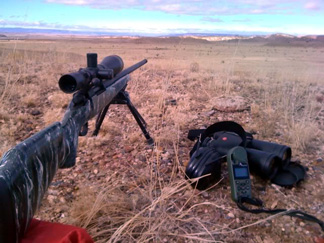quote:
Imagine a “smart scope” that can range your target AND calculate windage correction. Such technology may appear in riflescopes fairly soon. The Israeli Government’s Soreq Nuclear Research Center has received a U.S. patent for a new laser-based technology that can gauge wind vectors as well as target distance, using a laser rangefinder coupled to a rifle-scope. The Israeli system is called LIDAR, an acronym for Laser Identification Detection And Ranging. This new technology could, potentially, be a major boon for long-range shooters, both military and civilian. Ironically LIDAR was first developed for environmental monitoring (not for use with weapons). A LIDAR system was used for 3-D mapping and modeling of wind-driven plumes from the Israel Electric Company’s Rabin power plant.
Credit The Firearm Blog for breaking this story on the new Israeli LIDAR technology for sniper scopes. The Firearm Blog also first published the LIDAR fire control system patent documentation linked below. There you’ll find the patent Abstract, which has a good summary of how LIDAR reads the wind.
The new Israeli LIDAR unit gauges wind speed by detecting fluctations in laser signals sent out from the integrated scope/LRF, reflected back from the target, and then received by photodiodes in the scope/LRF. Other scopes have used built-in LRFs to measure distance-to-target, but Israel’s patented LIDAR goes one step further, using the laser to gauge BOTH target distance AND wind vectors (i.e. velocity + direction). This information is entered automatically into software. The software then calculates a ballistic solution compensating for distance, wind angle, and wind velocity. If it really works, LIDAR represents a remarkable technological achievement. The Israelis claim LIDAR works for targets at distances of 500m or greater. Why won’t it work at closer ranges? Presumably the wind-induced laser fluctuations are too small to register at closer distances.
Current Integrated LaserScopes for Hunters
While the Israeli LIDAR system may seem like science fiction, it’s not that far removed from the lastest commercial optics. Engineers on both sides of the Atlantic have already integrated laser rangefinders (LRFs) into rifle-mounted “consumer” optics. Just this year, Burris introduced an affordable “consumer” scope, the Eliminator, that ranges the distance to target and then displays the ballistically correct aiming point on the vertical crosshair. The amount of hold-over is automatically calculated with reference to ballistics formulas. At right is a view through the Burris Eliminator; the illuminated dot shows the calculated aiming point.
While such technology can help a shooter compensate for bullet drop, windage compensation is another matter. A shooter must still gauge crosswind angle and velocity, and then hold left or right accordingly. If the LIDAR system can perform this task reliably, that is a major advancement.
DARPA “One Shot” System to Have Wind-Reading Capability
Meanwhile, in the United States, the Defense Advanced Research Projects Agency (DARPA) is proceeding forward with a One-Shot Sniper System, another “Super-Scope” that will have day/night capability, and calculate both elevation AND windage correction automatically. Prototypes have already been tested, demonstrating that a laser beam can be used to “measure the average down-range crosswind profile”. The wind data is combined with readings of temperature, humidity, and target range to provide a very sophisticated ballistic solution. DARPA’s Spec for the One Shot program calls for a 12-42X Direct View Optic (DVO), a Riflescope Display Assembly (RDA), and an Integrated Spotting Scope (ISS) with rangefinder that ranges to 2 km, and provides “crosswind measurements”. The system will be “menu-selectable” for .308 Win, .338 Lapua, and .300 Win Mag. DARPA has budgeted big bucks for the One Shot system. The ISS, by itself, is expected to cost $85,000 per unit (for the first 15 units).
These systems will never replace the utility of an experienced shooter who possesses the skills of wind reading, but it is a real boon for less experienced shooters. In terms of military utility, it is a game changer. I’ve seen and used a prototype of the One Shot, and it does perform as advertised. — SFC Emil Praslick III, USAMU Coach
Can Wind-Reading Systems Work in the Real World?
From what we can tell, the LIDAR system, and America’s competing One Shot System, are both designed to measure crosswind speed and angle AT THE TARGET primarily. But as any experienced long-range shooter knows, wind is rarely constant along the entire path of the bullet. There can be a 10 mph left wind near the firing point, a 5 mph tailwind in mid-trajectory, and a 20 mph right wind 1000 yards away. Importantly, wind close to the shooter has more effect on the bullet’s path than wind far downrange — that’s a matter of simple geometry. Therefore, any wind-reading system could provide incorrect solutions if it is not able to read and calculate different wind vectors along the full bullet flight path. Presumably LIDAR and One Shot systems will attempt some kind of crosswind averaging, but that will be a very challenging task, without multiple wind sensors downrange.


 The Accurate Reloading Forums
The Accurate Reloading Forums  THE ACCURATE RELOADING.COM FORUMS
THE ACCURATE RELOADING.COM FORUMS  Rifles
Rifles  Long Range Shooting
Long Range Shooting  Using Lasers to Measure Wind
Using Lasers to Measure Wind






 The Accurate Reloading Forums
The Accurate Reloading Forums  THE ACCURATE RELOADING.COM FORUMS
THE ACCURATE RELOADING.COM FORUMS  Rifles
Rifles  Long Range Shooting
Long Range Shooting  Using Lasers to Measure Wind
Using Lasers to Measure Wind

